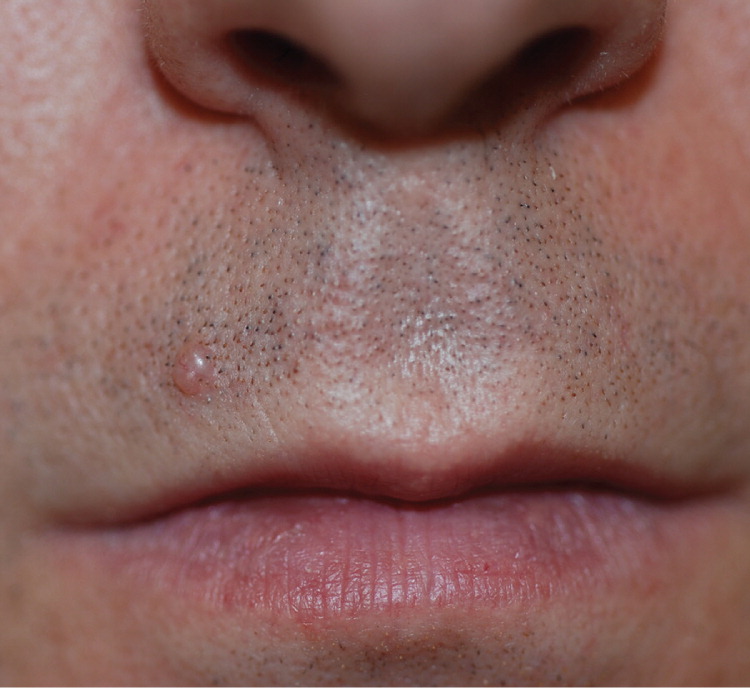
Am Fam Physician. 2015;91(12):869-870
Author disclosure: No relevant financial affiliations.
A 42-year-old man with a history of basal cell carcinoma on his scalp (five years earlier) presented for an annual examination. He reported inconsistent sunscreen use and did not have any new or concerning lesions. He did have a papule on his upper lip that had not changed in shape, size, or color since he first noticed it 10 years earlier. He had nicked it many times while shaving.


Question
Discussion
The answer is E: palisaded encapsulated neuroma, also known as a solitary circumscribed neuroma. This is a common benign neural tumor that may be misdiagnosed as a carcinoma.1 It presents as a small (2 to 6 mm), asymptomatic, skin-colored, firm, dome-shaped papule. It most often occurs on the mucocutaneous junction of the face in patients between 40 and 60 years of age. Men and women are equally affected.2
Palisaded encapsulated neuromas usually have no hair on the surface and minimal or absent telangiectasia; however, trauma to the area can cause prominent telangiectatic vessels and ulceration.2 Histologically, these neuromas appear as a partially encapsulated dermal nodule. The cause is unknown, but it has been suggested that they are a trauma-induced hyperplasia of the nerve fibers.3 Excision is typically curative.4
An epidermal inclusion cyst usually presents as a 1- to 4-cm, solitary, firm, mobile, subcutaneous nodule on the trunk, neck, or face. A white, cheesy material (accumulated keratin debris) can be expressed from the cyst with a surface punctum.7
A solitary neurofibroma presents as a soft sessile or pedunculated papule, usually on the trunk, that invaginates with pressure (“buttonholing”).5 Multiple neurofibromas are associated with von Recklinghausen disease, or neurofibromatosis 1. Other clinical features include café au lait spots, axillary freckling, and iris hamartomas (Lisch nodules).

| Condition | Characteristics |
|---|---|
| Basal cell carcinoma | Dome-shaped papule or nodule that may ulcerate or bleed; raised, pearly, rolled borders; telangiectasia forms an arboreal pattern on dermoscopy |
| Epidermal inclusion cyst | 1- to 4-cm, solitary, firm, mobile, subcutaneous nodule; surface punctum that may express accumulated keratin debris |
| Intradermal melanocytic nevus | Soft with smooth edges and preservation of skin markings; brown pigment, comma-shaped vessels, and hair are often noted on dermoscopy |
| Neurofibroma | Soft sessile or pedunculated papule, usually on the trunk, that invaginates with pressure (“buttonholing”) |
| Palisaded encapsulated neuroma | Small, asymptomatic, skin-colored, firm, dome-shaped papule; usually no hair on the surface and minimal or absent telangiectasia |

